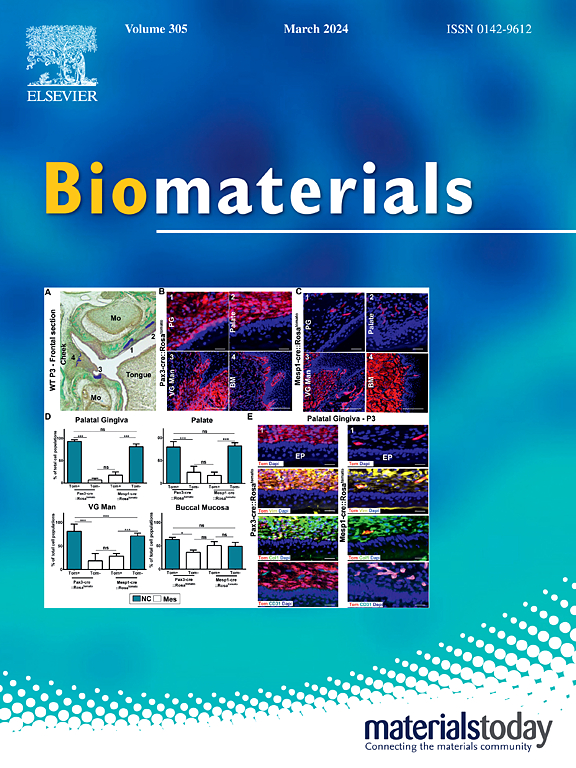An omics-based drug-HIFU combination therapy discovery for ferroptosis treatment of TNBC
IF 12.9
1区 医学
Q1 ENGINEERING, BIOMEDICAL
引用次数: 0
Abstract
Combination therapy, as a vital strategy in cancer treatment, aims to overcome the limitations of monotherapies by combining two or more drugs or treatments to enhance antitumor efficacy. However, the unclear interactions between different therapies and the difficulty of precisely identifying effective combination treatments remain major challenges. In this study, we developed an omics-based drug-HIFU combination therapy discovery framework taking ferroptosis treatment of triple-negative breast cancer (TNBC) as a paradigm. Using the transcriptomics of a large TNBC cohort, drug sensitivity databases, and transcriptomics of high-intensity focused ultrasound (HIFU)-treated cells, the interaction network between HIFU, key ferroptosis genes, and potential drugs was constructed to predict and identify novel drugs that target ferroptosis and synergize with HIFU. It was found that 11 candidate ferroptosis drugs demonstrated synergistic cytotoxicity with HIFU in 4T1 cells, which lacked previous reports. Especially, HIFU, by upregulating IL-6 expression by 2.69-fold, reduced the IC50 of panobinostat in 4T1 cells by 5.27-fold. Panobinostat was subsequently loaded into platelet-mimicking liposomes (Pan-PML) for tumor targeted drug delivery to amplify the synergistic effect of panobinostat and HIFU. Importantly, the combination of HIFU and Pan-PML resulted in significant inhibition of tumor growth in the 4T1 tumor model, with 50 % of mice remaining free of tumor and lung metastasis compared to those treated with HIFU or Pan-PML alone. Mechanistically, it was discovered that Pan-PML, in combination with HIFU, significantly inhibited histone deacetylase (HDAC) activity to 1/50 of the original level and further reduced the expression of the ferroptosis-related gene SIRT3 to 19.17 % of baseline, thereby synergistically promoting ferroptosis in tumor cells and activating anti-tumor immunity. Thus, this omics-based drug-HIFU combination therapy discovery framework provides an innovative method to screen the combination therapy, which leverages the synergistic effects of existing drugs and HIFU and enables combination treatments to maximize antitumor efficacy.

基于组学的药物- hifu联合治疗TNBC铁下垂的发现
联合治疗是一种重要的癌症治疗策略,其目的是通过联合两种或两种以上的药物或治疗来克服单一治疗的局限性,以提高抗肿瘤疗效。然而,不同疗法之间不明确的相互作用和精确识别有效联合治疗的困难仍然是主要挑战。在这项研究中,我们以铁下垂治疗三阴性乳腺癌(TNBC)为范例,建立了一个基于组学的药物- hifu联合治疗发现框架。利用大量TNBC队列的转录组学、药物敏感性数据库和高强度聚焦超声(HIFU)处理细胞的转录组学,构建了HIFU、铁下垂关键基因和潜在药物之间的相互作用网络,以预测和鉴定靶向铁下垂并与HIFU协同作用的新型药物。发现11种铁下垂候选药物对4T1细胞具有HIFU的协同细胞毒性,这在既往报道中是缺乏的。特别是,HIFU通过上调IL-6表达2.69倍,使panobinostat在4T1细胞中的IC50降低5.27倍。随后,Panobinostat被装载到血小板模拟脂质体(Pan-PML)中,用于肿瘤靶向药物递送,以扩大Panobinostat和HIFU的协同作用。重要的是,HIFU和Pan-PML联合治疗可显著抑制4T1肿瘤模型中的肿瘤生长,与单独使用HIFU或Pan-PML治疗的小鼠相比,50%的小鼠没有肿瘤和肺转移。机制上发现,Pan-PML联合HIFU可显著抑制组蛋白去乙酰化酶(HDAC)活性,使其降至原水平的1/50,并进一步将铁沉相关基因SIRT3的表达降低至基线水平的19.17%,从而协同促进肿瘤细胞铁沉,激活抗肿瘤免疫。因此,这个基于组学的药物-HIFU联合治疗发现框架提供了一种创新的方法来筛选联合治疗,利用现有药物和HIFU的协同作用,使联合治疗的抗肿瘤效果最大化。
本文章由计算机程序翻译,如有差异,请以英文原文为准。
求助全文
约1分钟内获得全文
求助全文
来源期刊

Biomaterials
工程技术-材料科学:生物材料
CiteScore
26.00
自引率
2.90%
发文量
565
审稿时长
46 days
期刊介绍:
Biomaterials is an international journal covering the science and clinical application of biomaterials. A biomaterial is now defined as a substance that has been engineered to take a form which, alone or as part of a complex system, is used to direct, by control of interactions with components of living systems, the course of any therapeutic or diagnostic procedure. It is the aim of the journal to provide a peer-reviewed forum for the publication of original papers and authoritative review and opinion papers dealing with the most important issues facing the use of biomaterials in clinical practice. The scope of the journal covers the wide range of physical, biological and chemical sciences that underpin the design of biomaterials and the clinical disciplines in which they are used. These sciences include polymer synthesis and characterization, drug and gene vector design, the biology of the host response, immunology and toxicology and self assembly at the nanoscale. Clinical applications include the therapies of medical technology and regenerative medicine in all clinical disciplines, and diagnostic systems that reply on innovative contrast and sensing agents. The journal is relevant to areas such as cancer diagnosis and therapy, implantable devices, drug delivery systems, gene vectors, bionanotechnology and tissue engineering.
 求助内容:
求助内容: 应助结果提醒方式:
应助结果提醒方式:


